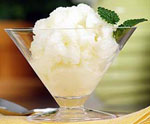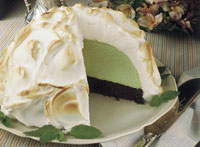 Summer brings long days, hot weather, and a symphony of seasonal sound. Crickets. Baseball ball games. Steaks sizzling on the grill. Children playing. And the unmistakable music of ice cream trucks. With tinkling melodies pouring forth these motorized Pied Pipers roll through the streets, and children come running from all directions. Clutching fistfuls of coins, they surround the truck like honeybees around a flower, then straggle away blissfully licking their favorite ice cream treats.
Summer brings long days, hot weather, and a symphony of seasonal sound. Crickets. Baseball ball games. Steaks sizzling on the grill. Children playing. And the unmistakable music of ice cream trucks. With tinkling melodies pouring forth these motorized Pied Pipers roll through the streets, and children come running from all directions. Clutching fistfuls of coins, they surround the truck like honeybees around a flower, then straggle away blissfully licking their favorite ice cream treats.
Frozen confections come in many forms. Cones piled high with teetering scoops. Soft slurpy swirls. Popsicles. Cookie sandwiches. Sodas and shakes. Fruit juice bars. Gelatos and granitas. Sherbets and sorbets. Luscious sundaes swimming in sweet sauces, dusted with toppings and crowned in whipped cream. We can thank modern refrigeration techniques for the myriad of choices available, but the desire to cool off with a refreshing cold treat on a hot sweltering day has been around since antiquity.
When Alexander the Great invaded the Indian city of Petra, thirty deep pits were dug and filled with snow so his army could cool their wine. Nero served crushed fruit mixed with snow and honey at his infamous orgies, and the Roman senator Seneca criticized his countrymen for the troubles their iced dessert passion incurred. Nonetheless, many an Imperial epicure cooled spiced wines and fruit juices with snow brought down from the Alps by relays of swift runners, an extravagance that even the most flagrant hosts found fiendishly expensive. In a letter to fellow gourmet Septitious Clarus, Pliny wrote: “How happened it, my friend that you did not keep your engagement the other night to sup with me?....I had prepared a lettuce, three snails, two eggs and a barley cake, with some sweet wine and snow. The snow most certainly I will charge to your account as a rarity that will not keep.”
 Both the Arabs and Turks enjoyed slushy ices called charab and chorbet, words which are the origins of syrup and sorbet. Rather than being the grand finale to a meal, these iced treats were served as palate refreshers between spicy meat and vegetable courses. Some were sweetened with mint syrup and delicate rosewater, but most were made with fruit juices especially lemon, the Middle East’s favorite citrus. When sherbets became popular in European cafes during the seventeenth century, they were often laced with liqueurs and served by men dressed in Arabian costumes.
Both the Arabs and Turks enjoyed slushy ices called charab and chorbet, words which are the origins of syrup and sorbet. Rather than being the grand finale to a meal, these iced treats were served as palate refreshers between spicy meat and vegetable courses. Some were sweetened with mint syrup and delicate rosewater, but most were made with fruit juices especially lemon, the Middle East’s favorite citrus. When sherbets became popular in European cafes during the seventeenth century, they were often laced with liqueurs and served by men dressed in Arabian costumes.
Legend has it that Marco Polo discovered the method for freezing sweet cream as well as the skill of making noodles during his sojourns in China. While there is evidence that the Chinese froze sweetened ground rice with milk, the Italians had stored ice for culinary purposes in underground vaults since the days of Rome and both techniques may have evolved independently in Italian kitchens.
With Venice the crossroads for maritime trade during the Renaissance, Italian culture influenced all aspects of European life. When Catherine de Medicis married the heir to the French throne in 1533, she arrived in Paris with wagonloads of kitchen supplies and a retinue of cooks whose culinary skills astounded the royal court. Not least among their innovative culinary wizardry was an iced cream dessert called gelati.
Lemonade, chilled with floating chunks of ice and frequently alcohol spiked, had also appeared on the culinary scene. Street vendors known as limonadiers popularized the drink in Paris, and in 1686, a clever fellow named Procopio dei Coltelli opened a cafe opposite a busy theater. Its mirrored walls, glittering chandeliers and marble-topped tables set the standard for all cafes that followed just as its menu of water ices and iced creams laid the foundation for the entire ice cream industry.
 Frozen desserts became the rage and French cooks devised a cornucopia of delights to satisfy public demand. Bombes, thick water ice shells with ice cream centers; coupes glacees, ice creams mixed with bits of fruit; parfaits, layers of ice cream and gooey sweet sauces; mousses, frothy frozen flavored whipped creams. The most elaborate offering, a baked meringue encasing one or more ice creams, was named Omelette a la Norvegienne in recognition of Norway’s role as Europe’s chief ice supplier. More than a century later it appeared in America as Baked Alaska.
Frozen desserts became the rage and French cooks devised a cornucopia of delights to satisfy public demand. Bombes, thick water ice shells with ice cream centers; coupes glacees, ice creams mixed with bits of fruit; parfaits, layers of ice cream and gooey sweet sauces; mousses, frothy frozen flavored whipped creams. The most elaborate offering, a baked meringue encasing one or more ice creams, was named Omelette a la Norvegienne in recognition of Norway’s role as Europe’s chief ice supplier. More than a century later it appeared in America as Baked Alaska.
Though England had a long history of cream-based desserts (custards, trifles, fruit fools, and frothy syllabubs), it was a Frenchman who introduced ice cream to the English court. Charles I was so enamored of Gerard Tissain’s glacees that he paid the chef an annual pension to keep the formula secret. When the king was beheaded, a group of nobles made the ice cream maker an offer he could not refuse. He could sell them the recipe or follow his majesty to the execution block.
While serving as ambassador to France, Thomas Jefferson tasted creme chantilly, a frozen egg-based sweet whipped cream flavored with vanilla, and immediately obtained the recipe for his personal cook. George Washington was such an ice cream fan that in the summer of 1790, he spent two hundred dollars to satisfy his cravings. Nevertheless, in early America ice cream was an unfamiliar treat in even the most sophisticated circles. When Dolly Madison served an ice cream pie at her husband’s second Inaugural Ball, one guest tasted the strange frozen custard and screamed, “Poison!” Security guards leaped to haul the chef away, but Dolly coolly came to his rescue and ice cream became a staple at State dinners.
For centuries iced treats were simply made by packing ice around a container of custard or fruit juice until the mixtures froze. During the Middle Ages alchemists learned that adding salt to the surrounding ice caused liquids to freeze faster. Centuries passed before the thermodynamic principle was understood. Salt causes ice to melt and the rapid exchange of energy actually lowers the environmental temperature.
In 1846, an American named Nancy Johnson invented a hand-cranked ice cream churn in which a rotating dasher beats the cream, inhibits the formation of large ice crystals and adds just enough air so that the final product melts quickly on the tongue. At about the same time, advanced mining techniques made salt, which had once been so hard to come by it was used in lieu of money, a cheap commodity. Suddenly, anyone could make a batch of ice cream easily and comparatively inexpensively.

 In 1904, a Syrian immigrant named Ernest A Hamwi set up a booth at the St. Louis World’s Fair to sell ice cream and thin Persian waffles called zalabia. It was a hot day, sales were booming and Ernest soon ran out of ice cream containers. He quickly made a big batch of waffles, rolled them up in a cone shape and served his ice cream in the crisp waffle cones. The idea took off like wildfire. An automated cone-making device was invented five years later, and within twenty years, 245 million ice cream cones were being produced annually.
In 1904, a Syrian immigrant named Ernest A Hamwi set up a booth at the St. Louis World’s Fair to sell ice cream and thin Persian waffles called zalabia. It was a hot day, sales were booming and Ernest soon ran out of ice cream containers. He quickly made a big batch of waffles, rolled them up in a cone shape and served his ice cream in the crisp waffle cones. The idea took off like wildfire. An automated cone-making device was invented five years later, and within twenty years, 245 million ice cream cones were being produced annually.
The stage was set for ice cream to become the world’s Number One favorite treat. Enter Harry Burt Sr. Believing that eating certain foods had the potential to affect one’s state of mind, Harry designed a chocolate covered block of ice cream on a stick, wrapped it in foil paper and named it the Good Humor Bar. Ice cream had been sold by street vendors for more than four hundred years, but Harry took it one step further. He outfitted a fleet of vans with tinkling bells to announce their presence as they rolled through the streets. The ice cream Pied Pipers had arrived.
Originally published by the Los Angeles Times, May 1998
Edythe Preet, former Culinary Historian for the Los Angeles Times Syndicate, presently
heads up The Heritage Kitchen which offers a wide range of treats based on heirloom
recipes as well as superb examples of mid-century American vintage linens.
